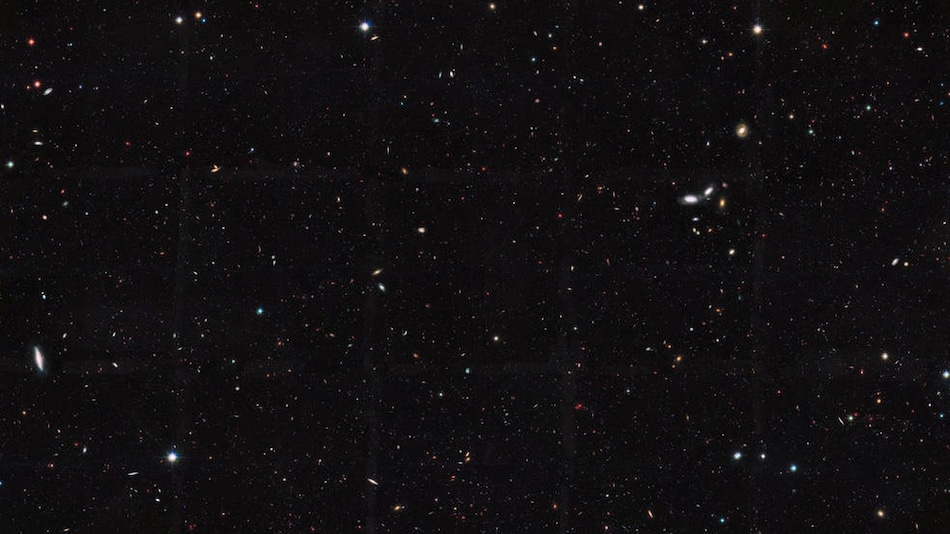- Home
- Science
- Science News
- Deep Field Week: NASA Highlights 2016 Study That Showed There Existed 2 Trillion Galaxies
Deep Field Week: NASA Highlights 2016 Study That Showed There Existed 2 Trillion Galaxies
Hubble Space Telescope's Deep Field images help us understand the formation and evolution of galaxies.

NASA during the 'Deep Field Week' want to discuss how big the Universe is
NASA's Hubble Telescope has shared a stunning image of a portion of a large galaxy census known as the Great Observatories Origins Deep Survey (Goods). It shows a number of galaxies, denoted by sparkling dots scattered on a dark canvas as if a handful of grains are sprinkled on a dark background. The Twitter post wants to talk about how big our universe is. But determining that could be difficult. For any success, we need to first find out how many galaxies are there in the universe. This question has long perplexed scientists. Thanks to the Hubble Deep Field in the mid-1990s, they were able to get the first real insight into the galaxy population.
Subsequent observations such as Hubble's “Ultra Deep Field” revealed a myriad of faint galaxies and led to an estimate that the observable universe had about 200 billion galaxies. But scientists in 2016 found out that the universe is a lot more crowded. They came to the conclusion that there are at least 10 times more galaxies in the universe than previously thought.
Let's talk about how huge our universe is. ????
— Hubble (@NASAHubble) August 3, 2021
The Hubble Ultra Deep Field led to an estimate that the observable universe contained at least 200 billion galaxies. But research from 2016 suggests that number is at least 10 times too low: https://t.co/FKh3WTJlKU#DeepFieldWeek pic.twitter.com/MrxIcaYzya
NASA shared the social media post as part of the 'Deep Field Week”', a social media event during which images captured by the Hubble Space Telescope are being shared to recall the early studies of the universe and how they evolved through time. Deep field images help us understand the formation and evolution of galaxies.
Mark your calendars! ✏️
— Hubble (@NASAHubble) July 30, 2021
Hubble's #DeepFieldWeek is happening August 2-6.
Follow along on social media as we take a deep dive into some of Hubble's most iconic images and what they've taught us about our universe – and ourselves.
Find out more here: https://t.co/RKGEJyn9E5 pic.twitter.com/EJL00pzhWh
Coming back to the 2016 study, astronomers also found that the galaxies were not evenly distributed throughout the universe's history, meaning a significant galaxy evolution dramatically reduced the number of galaxies through mergers between them.
The decreasing number of stars also solved another question that had confused scientists until then – the Olbers' paradox, relating to the problem of why is the sky dark at night if the luminous stars are distributed evenly throughout an infinite universe.
The scientists involved in the study concluded that the starlight from the galaxies is invisible to the human eyes because of the expansion of space, the universe's dynamic nature, and the absorption of light by intergalactic dust and gas.
For the latest tech news and reviews, follow Gadgets 360 on X, Facebook, WhatsApp, Threads and Google News. For the latest videos on gadgets and tech, subscribe to our YouTube channel. If you want to know everything about top influencers, follow our in-house Who'sThat360 on Instagram and YouTube.
Related Stories
- Samsung Galaxy Unpacked 2025
- ChatGPT
- Redmi Note 14 Pro+
- iPhone 16
- Apple Vision Pro
- Oneplus 12
- OnePlus Nord CE 3 Lite 5G
- iPhone 13
- Xiaomi 14 Pro
- Oppo Find N3
- Tecno Spark Go (2023)
- Realme V30
- Best Phones Under 25000
- Samsung Galaxy S24 Series
- Cryptocurrency
- iQoo 12
- Samsung Galaxy S24 Ultra
- Giottus
- Samsung Galaxy Z Flip 5
- Apple 'Scary Fast'
- Housefull 5
- GoPro Hero 12 Black Review
- Invincible Season 2
- JioGlass
- HD Ready TV
- Laptop Under 50000
- Smartwatch Under 10000
- Latest Mobile Phones
- Compare Phones
- Motorola Edge 60 Stylus
- Moto G Stylus (2025)
- Oppo Find X8s+
- Oppo Find X8s
- iQOO Z10x
- iQOO Z10
- Oppo Find X8 Ultra
- Vivo V50e
- Asus Vivobook 16 (AMD, 2025)
- Asus Zenbook S16 (AMD, 2025)
- Oppo Pad 4 Pro
- Samsung Galaxy Tab S10 FE+
- Oppo Watch X2 Mini
- Garmin Instinct 3 Solar
- Xiaomi X Pro QLED 2025 (43-Inch)
- Xiaomi X Pro QLED 2025 (55-Inch)
- Nintendo Switch 2
- Sony PlayStation 5 Pro
- Whirlpool 1.5 Ton 3 Star Inverter Split AC (SAI18K38DC0)
- Whirlpool 1.5 Ton 5 Star Inverter Split AC (SAI17B54SED0)

















